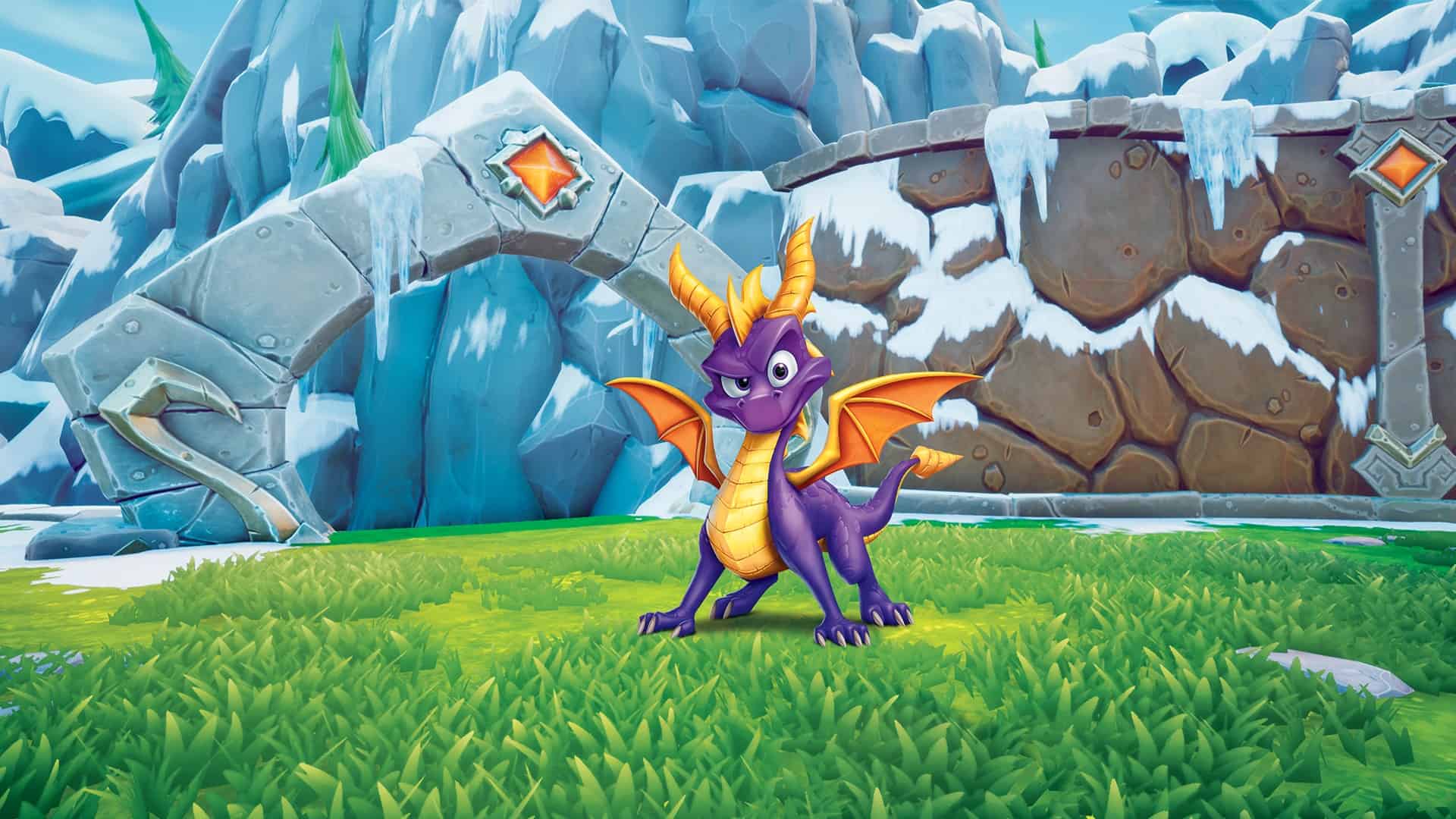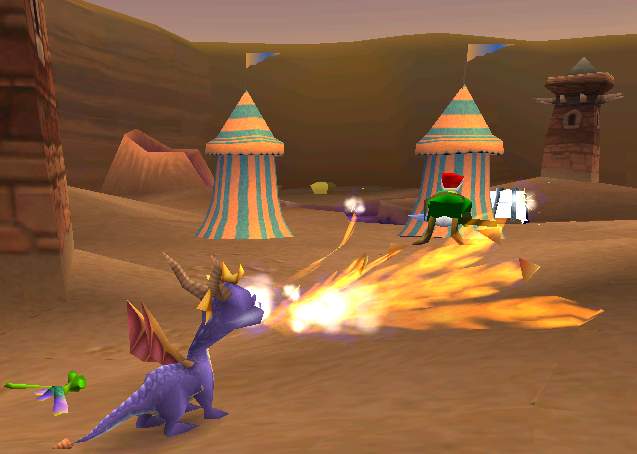
Spyro the Dragon is making a big comeback, so now is the perfect time to check out Spyro Overview.
The Purple Dragon rises from the ashes! We’ve been waiting for the return of the classic Spyro games for years, and thanks to Spyro: Reignited Trilogy, our scaly friend is finally back. As many die-hard Spyro fans know, it hasn’t been an easy road for the series. So let’s join together and tell the story of dragons, myths, legends, and Spyro the Dragon.
In the winter of 1996, Insomniac Games released their first game, Disruptor. The game received good reviews, but sales were not so high. This brought Insomniac to the brink of bankruptcy. Fortunately, Universal Interactive Studios (which had published Disruptor) wanted to continue working with the studio. Mark Cerny, who was an executive producer at Universal at the time, advised Insomniac to create a more family-friendly game aimed at a younger audience. The company decided on two ideas: one about aliens conquering Earth, and another about dragons. Insomniac chose the latter, while the former eventually became Resistance: Fall of Man. (But that’s for another time…)
The game proved difficult to run properly, as Insomniac had difficulty estimating the processing power of the PlayStation. The console froze and caught fire, forcing the team to consider numerous kits. Insomniac quickly found a solution to save power: the game is programmed to combine two different environment models, one with simple polygons, and one with more detailed textures and models. This would allow the team to do more with the game without worrying about yet another broken console.
Of course, you can’t talk about Spyro without mentioning the game’s composer, Stewart Copeland. Prior to starting this project, Copeland was known as the drummer for The Police and worked as a composer for several films and television shows. Insomniac hired Copeland late in development. His approach was to play through the game’s levels and then write the music for them. Copeland admitted that he was bad at games and sometimes needed cheat codes to progress more easily.
Spyro the Dragon was released in North American retail stores on September 9, 1998, and in Europe a month later. The game was widely praised for its vivid, detailed graphics and sold over five million copies. Before they knew it, Insomniac had succeeded in creating another PlayStation mascot to rival Naughty Dog’s Crash Bandicoot. It was clear what Insomniac’s next project would be.
Development of the Spyro sequel began shortly after the release of the first game. While there weren’t many complaints about the first game, Insomniac felt that “Spyro” placed too much emphasis on collectibles, making parts of the game feel tedious. The studio decided to remove most of the collectibles in favor of a variety of missions and quests. This kept the game fresh, forcing players to complete different tasks almost constantly.

Spyro 2: Ripto’s Rage was released in November 1999 and was well received by fans and critics. The game was praised for including new moves for Spyro and offering unique gameplay with a variety of quests and mini-games. Sales were not as good as the first Spyro, but were enough to justify another sequel.
The goal for the third Spyro game was simple: make the game bigger and better. How could Insomniac achieve this without making the formula boring? In addition to adding more mini-games, the team took a different approach to combat and exploration. Instead of giving Spyro more moves, Insomniac decided to include multiple playable characters, meaning players wouldn’t be overwhelmed with a long movelist, while at the same time introducing new characters and experimenting with different gameplay.
Spyro: Year of the Dragon was released in North America on October 24, 2000. Europe had to wait until November 10, 2000. Critics gave the game glowing reviews, and fans considered Year of the Dragon to be the best game in the series. The camera may have been frustrating, but the mini-games and level design kept players coming back. Unfortunately, this would be Insomniac’s last Spyro game. The studio had had its day with the dragon and felt it had run out of ideas. It was time to move on, but Universal wasn’t ready to give up on Spyro just yet.
With the arrival of the next generation of consoles just around the corner, Universal wanted to release a new Spyro game as soon as possible. Two studios accepted the challenge: Equinoxe Digital Entertainment and Check Six Studios, the companies behind the latest game Spyro: Enter the Dragonfly. At first, everything seemed to be going smoothly, but ultimately, the relationship turned out to be as stable as a three-legged coffee table. The Equinoxe and Check Six teams frequently clashed over creative differences, and tensions eventually led to director Joel Goodsell’s resignation midway through development. Enter the Dragonfly was on the verge of being canceled after a bitter argument between the managers. In fact, lead engineer and project coordinator Warren Davis had to lock them in a room to solve the problem, effectively saving the project and everyone’s jobs.
Unfortunately, this wasn’t enough to save the final product. Spyro: Enter the Dragonfly was released in November 2002 for the PlayStation 2 and Nintendo GameCube. It started off badly… Enter the Dragonfly received disastrous reviews! From the bland and empty world to the various bugs and glitches, the whole experience felt like an unfinished Spyro game. This has to be the absolute nadir of the Spyro series.
In the years that followed, Spyro was included in a number of lukewarm handheld games. Spyro: Season of Frost and Spyro 2: Season of Fire had a decent following, but other titles like Shadow Legacy for the DS and the crossover with Crash Bandicoot were terrible. The only console title to come out of the series during this time was Tail of the Hero, but it failed to restore the dragon to its former glory.

Though Spyro never made the impact it once had, Universal Studios Interactive (now Vivendi Universal Games) eventually commissioned Krome Studios to reboot Spyro. The studio was previously known for producing the Ty the Tasmanian Tiger series. During the development of the Legend of Spyro series, Chrome changed the tone and focus of the original games. The trilogy placed an emphasis on combat and gave Spyro more movement. Exploration was treated as an afterthought, coming to the fore only in the final game of the new trilogy, The Legend of Spyro: Dawn of the Dragon. This is arguably the opposite of the philosophy behind Insomniac’s original games. Nevertheless, the Legend of Spyro games gained a good following, but still didn’t gain the same traction as the earlier games.
In July 2008, late in the new trilogy period, Activision merged with Vivendi Games to form Activision Blizzard. With a new catalog of intellectual property, Activision was able to choose which series their studios wanted to work on. At the time, a studio called Toys for Bob was looking for a way to create a game based around a toy. Spoiler alert: they chose “Spyro.” But why? Was it just an additional name to the original game? Instead, Toys for Bob believed this would allow Spyro to make another impression on the gaming industry. It was just too far-fetched not to try! Plus, Toys for Bob didn’t want to reboot Dragons or revisit familiar territory. This would also be a great way to introduce Spyro to a younger audience. Could this be the start of a better future?
Back in October 2011, Skylanders: Spyro’s Adventure was released to great success. The game was critically acclaimed and grossed over $500 million as of December 2012. Mission accomplished: putting Spyro back in the spotlight. Unfortunately, with each release coming every year and each title bringing a new gimmick, our fire-breathing friend was quickly overshadowed by the franchise. At this point, he was already known as “Spyro from Skylanders.”
Well, it’s finally time for Spyro to make his triumphant return in Spyro: Reignited Trilogy. Thanks to the phenomenal success of Crash Bandicoot: N-Sane Trilogy, Activision has shown renewed interest in reviving classic series, with our Purple Pal being next to get the remaster treatment. Could this be the first step towards a full-scale return? We’ll have to wait and see.

Leave a Reply